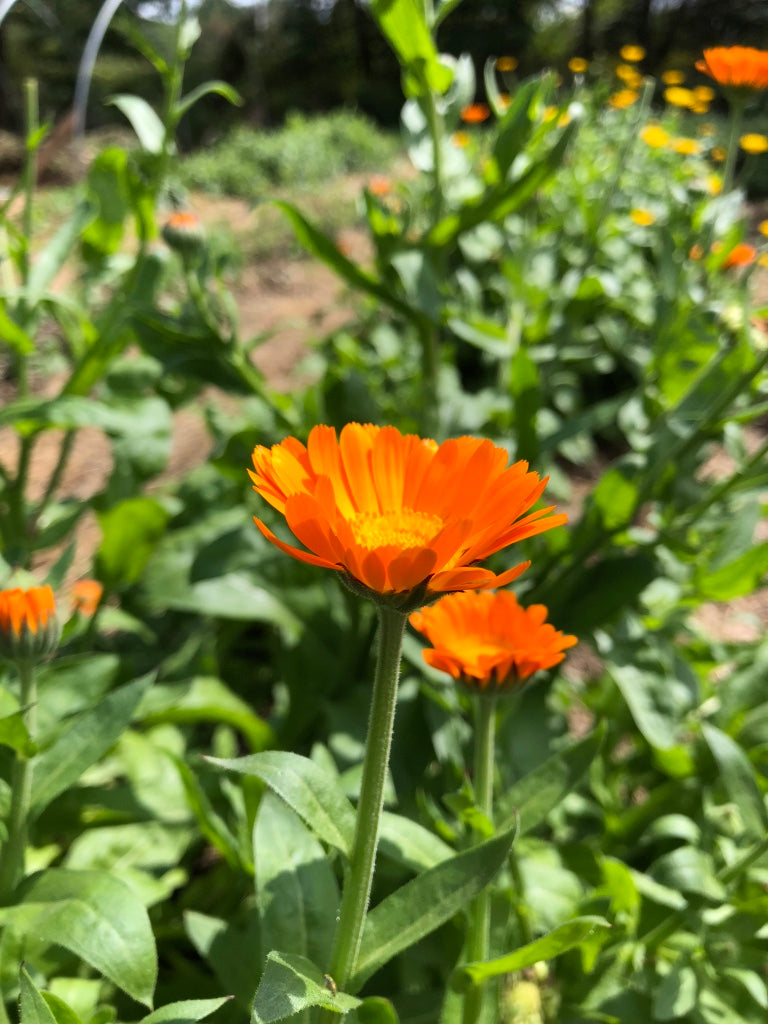
Highlighting a key herb in The Healer Balm
Calendula officinalis, asteracea
Calendula is a wound healing herb externally and a lymphatic internally. A sunny hued flower with a gentle astringency that tones our mucosal lining and our skin. Calendula can reduce excess inflammation in some cases when applied correctly.
A few of my favorite ways to work with Calendula:
- Making a strong water infusion to soothe irritated cuts or scrapes. If the cuts are on your fingers (hello fellow artists and gardeners) soaking them directly in a lukewarm infusion can be really effective. Soaking a cloth in the infusion and then applying it to the abrasion also works. Try to keep the Calendula infusion in contact with the cut for at least 15 minutes. Side note: always clean your wounds before you do anything else.
- Infusing Calendula in oil for first aid kits, skin care, and lymphatic massage - an all purpose balm! The skin supporting properties are especially noticeable in cases where there is irritation or blemishes that need quick healing. Herbal wisdom tells us that Calendula is a solar herb - ruled by the sun and gently warming and drying - specific to places where the sun doesn’t shine: our breasts, underarms, and groins. Massaged into these often sun-less places, Calendula encourages lymph flow.
- As a hot water infusion (aka tisane or “tea”) or tincture diluted in water. This is a way to work with Calendula as a gentle lymphatic or for its gut soothing qualities. Calendula is a staple of an herbal tea blend I make that’s primary goal is to soothe an irritated digestive system.
Calendula is native to parts of Southern Europe, Northern Africa, and the Eastern Mediterranean area. A beloved herb, Calendula is naturalized all over the globe, and often returns to the same garden year after year as a self seeding annual. This is an easy herb to grow, doesn’t take up too much space in the garden and is a prolific producer!
Harvest the flowers just as they begin to open. On the herb farm, we are perpetually cutting back the flowers and bringing them to the drying rack, only to see the Calendula plants bursting with blooms again a few days later. We harvest the flowers in mid-day when the morning dew has evaporated and the resins are in their highest concentrations. We prune the plants as we pick blossoms to keep them vibrant and healthy. We dry the flowers in our solar dehydrator and store them in jars in a cool, dark place to keep them vibrant and ready to go all year long.
Medicine Making: I highly recommend drying Calendula before working with it. Drying calendula concentrates the resins which account for some of the medicinal properties, and make for a stronger preparation.
Calendula oil: Dried Calendula flowers infused in oil at a 1:4 ratio (one part calendula, four parts oil)
Calendula tincture: Dried Calendula flowers infused in 70% alcohol at a 1:5 ratio (one part calendula, five parts 70% alcohol)
Calendula in a gut healing tea formula:
2 parts calendula
2 parts plantain
2 parts chamomile
1 part peppermint
1/2 part fennel seeds (crushed)
1/4 part licorice
Thanks for reading! Check out The Healer Balm to experience Calendula's herbal properties for yourself.


